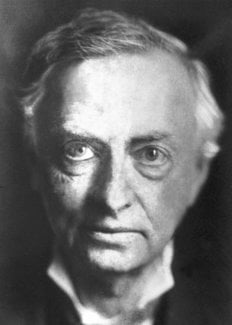Karl Gjellerup
Biographical

I was born on June 2, 1857, in the Roholte vicarage at Praestö. My father was Pastor Carl Adolph Gjellerup, my mother, Anna Fibiger. After my father’s death in 1860, in Landet vicarage on Lolland (from which I still have a number of memories), I went in November of the same year to the home of my mother’s cousin, Pastor Johannes Fibiger, parish minister of the garrison church in Copenhagen, and author of Johannes den Døber (1857) [John the Baptist], Nogle sagn (1865) [Some Stories], Kors og kaerlighed (1858) [Cross and Love], Den evige strid (1878) [The Eternal Strife], and Mit liv og levned (1898) [My Life]. I was graduated summa cum laude from Haerslevs Grammar School in 1874. Before this I had made several attempts at writing; immediately after graduation I wrote a tragedy, Scipio Africanus, and a drama, Arminius, both of which were shown to my uncle, Professor Edvard Holm, who encouraged me and showed the latter to Christian Molbech. Nevertheless, I studied theology and lived much in the country (in Vallensved on South Sjaelland, where Fibiger was the minister, and after 1881 in Ønslev on Falster), a country life which made an indelible impression on my mind and has left its mark in all of my novels. I earned my B.D. (summa cum laude) in June of 1878. I immediately began writing En idealist (1878) [An Idealist], which was published in November on the same day as Den evige strid, both under a pseudonym. Because both books created something of a sensation, I then came into contact with Høffding, Drachmann, Schandorph, Borchsenius, the brothers Brandes, J. P. Jacobsen, and many artists. Ceaseless production followed, temporarily taking a scientific direction in Arvelighed og moral (1881) [Heredity and Morals], a book with an evolutionary viewpoint, which was awarded the University Gold Medal. The novel Germanernes laerling (1882) [The Apprentice of the Teutons] (in its very title a program for existence), a collection of poems entitled Rødtjørn (1881) [Hawthome], end Aander og tider (1882) [Spirits and Times], a requiem on Darwin, are the most noteworthy works from this time. A small inheritance made it possible for me to undertake a longer trip abroad in 1883. During a three-month stay in Rome, I pursued studies in water colour with Kronberg; later I studied pastel and oil painting. My return trip went through Switzerland, Greece, and Russia, and via Stockholm I arrived home at Christmastime. In the meantime two short stories, «Romulus» (1883) and «G-Dur» (1883) [G-Major], had come out. The travel impressions, En klassisk maaned (1884) [A Classical Month] and Vandreaaret (1885) [Wander Year], followed. In the latter of these two I broke off from the followers of Georg Brandes. Then appeared the first work of mine which was received with excitement, the lyrical tragedy Brynhild (1884), which had already been sketched during my student years, and which was dedicated to Eugenia. From the summer of 1885 to the fall of 1887 I lived in Dresden, where I wrote the scenes from the revolution, Saint Just (1885) (reworked for the stage in German in 1913 and still not published), and the dramatic-lyrical poem «Thamyris» (1887). The latter along with Brynhild was responsible for my receiving a state pension for life. In October of 1887 I married Eugenia Bendix, née Heusinger, and settled in Hellerup. The lyrical tragedy Hagbard og Signe (1888) [Hagbard and Signe], the novel Minna (1889), the poetry collection Min kaerligheds bog (1889) [The Book of my Love], and the plays Herman Vandel (1891) and Wuthhorn (1893) (performed at the Dagmar Theatre over 100 times) were written in Hellerup. I also wrote an essay about Wagner’s Nibelungenring and translated the songs of the gods in the Edda.
In March of 1892 I settled in Dresden. The tragedy Kong Hjarne (1893) [King Hjarne] and the verse comedy Gift og modgift(1898) [Toxin and Antitoxin] were performed at the Dagmar Theatre. After Fabler [Fables], Fra vaar til høst [From Spring to Autumn], and To fragmenter [Two Fragments] I bade farewell to Danish poetry. The novels Møllen (1896) [The Mill], Ved graensen (1897) [At the Border], Tankelaeserinden (1901) [The Soothsayer], and Rudolf Stens Landpraxis or Reif für das Leben ( I9I3) [Ripe for Life] were written in German, and this language, in which I had made my debut with Pastor Mors (1894), now became my true artistic medium. The dramas Die Opferfeuer (1903) [The Sacrificial Fires] (produced at the court theatres in Dresden and Dessau) and Das Weib des Vollendeten ( 1907) [The Wife of the Perfect One] (produced at the court theatre in Stuttgart) and the poetic novels Der Pilger Kamanita (1906)[The Pilgrim Kamanita], Die Weltwanderer (1910) [The World Travellers], Der goldene Zweig (1917) [The Golden Bough], and Die Gottesfreunde (1916) [The Friends of God] belong chiefly to German literature and – like Reif für das Leben – have found their true understanding and appreciation almost exclusively in Germany. When my first book appeared forty years earlier, it had been influenced by German idealism. Just three years later (in the thesis awarded the gold medal) I was a follower of English naturalism, after which I returned to a position under those elevated signs of the zodiac which constitute my rightful habitat, only this time the guiding star was not Hegel as in En idealist, but Kant and Schopenhauer.
Karl Gjellerup died in Klotzsche, near Dresden, in 1919.
This autobiography/biography was written at the time of the award and first published in the book series Les Prix Nobel. It was later edited and republished in Nobel Lectures. To cite this document, always state the source as shown above.
Karl Gjellerup died on October 11, 1919.
The Nobel Foundation's copyright has expired.Nobel Prizes and laureates
Six prizes were awarded for achievements that have conferred the greatest benefit to humankind. The 12 laureates' work and discoveries range from proteins' structures and machine learning to fighting for a world free of nuclear weapons.
See them all presented here.
